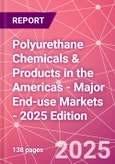This report provides an in-depth analysis on key product categories. This market report and online database provides a cost-effective tool for strategic decision making, allowing clients to monitor market metrics, trends and forecasts at a country or regional level.
The new study revises and updates the analyst's research of the polyurethane industry in the Americas. It builds upon ongoing research into various sectors conducted in recent years. The information contained within this report is based upon an extensive programme of interviews throughout the industry, involving raw materials producers and suppliers, end users, systems houses and relevant trade associations and industry experts.
Most research for this report was undertaken during the first half of 2025. This report therefore contains both PU product production and raw material consumption figures for the year 2024 and forecasts to 2029.
SCOPE OF THE STUDY
This report describes the supply and demand of raw materials in the following geographic regions:
- North America
- Canada
- USA
- Mexico
- South America
- Argentina
- Brazil
- Chile
- Colombia
- Peru
- Venezuela
- Rest of South America
METHODOLOGY
Information provided in this volume has been obtained from existing in-house data and an extensive programme of interviews with leading product manufacturers, trade associations, raw materials producers and systems houses across the Americas. Published data and statistics have also been reviewed in order to produce as accurate figures as possible for the consumption of raw materials in the production of polyurethane products. Forecasts for the production of PU products and consumption of raw materials have been calculated for the year 2029, based upon industry and economic forecasts as well as upon other relevant commercial and technical issues likely to affect individual market sectors and products. Slight discrepancies in the totals may occur, due to rounding.
PRODUCTS AND END-USES
The following major end-use sectors for polyurethane are covered in this volume:
- Automotive
- Building and Construction
- Footwear
- Furniture and Bedding
- Refrigeration
The major PU products covered in this volume include:
- Flexible Foam
- Moulded Foam
- Semi-rigid Foam
- Integral Skin Foam
- Slabstock
- Rigid Foam
- Laminated Panels (Continuous/Discontinuous)
- Slabstock
- Sprayed Foam
- Pipe-in-pipe Insulation
- One Component Foam (OCF)
- Refrigeration
- Coatings
- Adhesives
- Sealants
- Elastomers
- Cast
- Microcellular
UNITS OF VOLUME
All the volumes quoted in this report relate to tonnes of finished products, unless otherwise stated.
FORECASTS
The forecasts included in this report are based upon industry comments and economic indicators. It can be difficult to present a summary of forecasts for all the various types of polyurethane materials because of the many different factors which may affect the market. Manufacturers themselves are often unable to agree whether a market will increase or decrease, preferring instead to quote the factors most likely to influence it.
Forecasts for changes in production by product type and by each application are given for each country covered in this report. These are five-year forecasts, derived from industry comments and expectations, both from the end users and raw material sectors of the polyurethane industry.
FORMULATIONS
The multitude of proprietary formulations used in the various product sectors of the polyurethanes industry means that a number of assumptions have to be necessarily made with respect to product formulations. In this section, the assumptions made (expressed as % w/w formulations) in calculating raw material consumption by product are presented. Since volumes are derived from the below formulations, figures therefore are presented as exact figures.
Table of Contents
Methodology
Information provided in these reports are based on existing in-house data and an extensive programme of interviews with leading product manufacturers, trade associations, distributors and raw materials producers involved with the specific market researched. These interviews are conducted within the 3-6 months leading up to the publication of the study, with the duration of the research programme and the number of interviews completed depending on the scope of the study. The analyst publishes both regional and global reports, and in most cases, the interviews are conducted in the native language of the individual respondents.
In addition, published data and statistics are also reviewed in order to produce as accurate figures as possible for size of markets studied. Market forecasts are based upon industry and economic forecasts as well as upon other relevant commercial and technical issues likely to affect individual market sectors and products, as well as the interviews conducted for the study.

LOADING...








